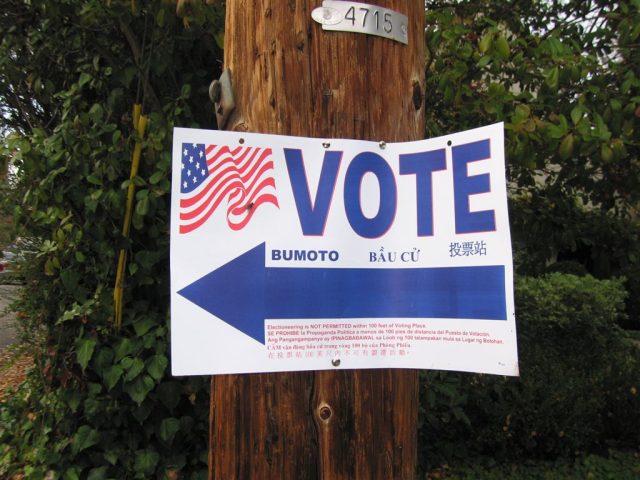
When people think they’re being watched, they’re more inclined to behave themselves. This behavior pops up again and again: in blood donation, energy saving, and charitable giving. There are many explanations for why this happens—maybe we think people are more likely to treat us well if they see us behaving in a prosocial way; in some cases, we might behave ourselves in front of others in order to avoid awkward conversations or having to lie.
Harvard researchers Todd Rogers, John Ternovski, and Erez Yoeli wanted to find out if they could leverage this tendency in order to increase voter turnout. A “get-out-the-vote” (GOTV) letter is a simple, impersonal reminder that has a small but noticeable effect on voter turnout. A meta-analysis of 79 experiments on the effects of GOTV letters found that, on average, they boosted turnout by 0.194 percentage points—for example, from 39 percent to 39.194 percent.
It’s a tiny figure, but if applied across the US, it would result in around 450,000 extra voters (out of an estimated 235,248,000 eligible voters). Not nothing, but still not a lot. Rogers, Ternovski, and Yoeli suspected that adding a hint of oversight to the letters could make a bigger difference.
To find out, they sent GOTV letters to 770,946 people ahead of the 2010 midterm elections. Half of the recipients received a letter thanking them either for past votes or for registering to vote and encouraging them to vote in the upcoming elections (the “best practices” group). The other half—the “observable” group—received exactly the same letter, with an important difference: a block in the top right-hand corner of the letter said “You may be called after the election to discuss your experience at the polls.” This message was reiterated in a paragraph in the letter itself.
Compared to a control group of 76,963 people, the “best practices” group saw a statistically significant jump in voter turnout. Based on administrative records, 41.36 percent of this group voted compared to the control group’s 40.88 percent. That’s 0.48 percentage points, more than double the increase found in the meta-analysis of 79 GOTV experiments.
This increase could be down to a difference in the "best practice" GOTV letters compared to those used in past experiments, the authors suggest. The letters used in the meta-analysis didn’t thank people for any past political actions, whereas the letters in this experiment did. This could also have made people aware that their voting actions could be observed, even without the promise of a follow-up.
The letters explicitly mentioning the possibility of being called after voting saw an even bigger boost: 41.6 percent turnout, which was an increase of 0.72 percentage points over the control group. It was also a statistically significant increase over the “best practices” group, although obviously by a much narrower margin of 0.24 percentage points.
Donald Green, a political scientist at Columbia University who was involved with the earlier meta-analysis, cautions that we should always look out for replications: “Follow up experiments are how we learn whether the results are specific to subject pool, the treatments, the electoral context,” he told Ars.
Nonetheless, it’s a robust study, he says, and is likely to draw the attention of political scientists. It’s particularly interesting that the effect size was similar to an experiment in 2012 that used Facebook to show people who among their friends had voted, he adds.
The effects of even these comparatively successful GOTV letters are still small compared to more personal tactics, Dr. Green emphasizes. However, they can be delivered at a relatively lower cost. At $0.34 per letter, a standard GOTV letter costs $175 per extra vote; the GOTV letter that mentions post-vote observation would cost just $47 for each extra vote that it generates.
The authors of the paper point out that decisions based on whether we're being observed might not be exactly rational (and they're right—in some studies, just an image of some eyes is enough to change behavior). We probably make these decisions intuitively, rather than engaging in an internal debate over whether we're likely to get called, if we'd lie about our voting, etc.
Beyond voter turnout, the results add to the immense pile of studies that point to the power of observation in getting people to contribute to the public good. If replications produce similar results, this could make boosting contributions to the public good much easier.
PNAS, 2016. DOI: 10.1073/pnas.1524899113 (About DOIs).
reader comments
26